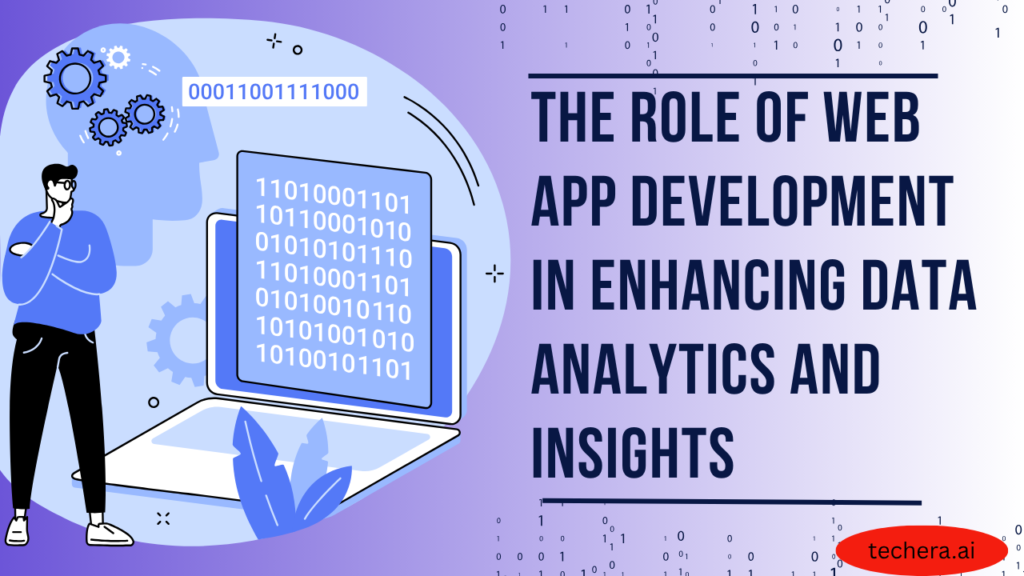
Discover how Web App Development plays a crucial role in streamlining data analytics and generating actionable insights. This blog explores the integration of modern web applications with data tools to enhance decision-making, improve user experiences, and drive business intelligence.
Introduction
We live in the age of data. Everything from your favorite shopping app to your smartwatch is collecting, analyzing, and using data to make better decisions. But how exactly do businesses harness all that data? Enter web applications—the unsung heroes driving modern analytics and insight generation.
Whether you’re running a startup or managing a global enterprise, web app development is increasingly becoming the backbone of data-driven decision-making. Let’s explore how.
What is a Web Application?
Definition and Key Features
Software that operates within a web browser is known as a web application. Unlike a simple website that just displays information, a web app is interactive, functional, and dynamic. Think of Gmail, Trello, or Netflix—these aren’t just pages to read; they’re platforms where users take action.
Difference from Static Websites
While static websites are like digital brochures, web apps are like digital machines. They collect input, process it, and respond based on logic. That makes them perfect for collecting and analyzing data.
Overview of Data Analytics
Definition of Data Analytics
Data analytics involves examining datasets to draw conclusions. It transforms unstructured data into insights, trends, and patterns that are useful for making decisions.
Types of Analytics
- Descriptive Analytics – What happened?
- Predictive Analytics – What’s likely to happen?
- Prescriptive Analytics – What should we do?
Web apps can support all three by acting as real-time data collection and visualization platforms.
The Intersection of Web Apps and Data Analytics

Web Apps as Data Collection Tools
Web apps can track every click, scroll, form entry, and session. This makes them ideal for gathering user behavior data with precision.
Real-Time Data Processing Capabilities
Modern web apps don’t just collect data—they can analyze it instantly. This enables faster decision-making and smarter responses.
Features of Web Apps That Empower Data Analytics
API Integrations
Need to pull data from third-party tools like Stripe, Google Analytics, or Salesforce? Web apps easily integrate with APIs to merge multiple data sources.
Dashboards and Visualizations
Interactive dashboards help visualize complex data with charts, graphs, and heatmaps, making insights easier to digest and act upon.
Automated Reporting
Set it and forget it. Web apps can auto-generate weekly reports, saving hours of manual work and ensuring consistency.
User Behavior Tracking
Track how users navigate your app in real time. Find friction points and optimize user flow—data makes it obvious.
Benefits of Using Web Apps for Analytics
Centralized Data Access
Web apps serve as a central repository for information gathered from multiple sources. No more hopping between tools because everything is in one location.
Improved Decision-Making
When everyone on your team has access to real-time insights, decisions aren’t based on guesses—they’re based on facts.
Scalable Infrastructure
Built on cloud-based architecture, web apps grow with your data. Your app won’t blink whether you have 100 users or one million.
Also Read : Top Challenges in Web App Development and How to Overcome Them
Role of Backend Technologies in Data Handling
Database Management
Behind every data-powered web app is a solid database—PostgreSQL, MongoDB, MySQL—that stores and retrieves data efficiently.
Server-Side Logic
Backends handle calculations, business rules, and user permissions—crucial for secure and accurate analytics.
Security and Compliance
Secure backend development ensures data encryption, authentication, and adherence to regulations like GDPR or HIPAA.
Role of Frontend in Delivering Insights
UX Design for Data Accessibility
If users can’t understand your analytics, they won’t use them. Web apps focus on user-friendly design to keep insights digestible.
Data-Driven Interfaces
Frontend frameworks like React and Vue allow real-time data updates without full page reloads—ideal for dashboards and monitoring tools.
Real-Time Analytics Through Web Apps
Importance of Live Data
In industries like e-commerce or finance, decisions need to be made on the fly. Web apps support live dashboards that provide second-by-second updates.
Use Cases: E-commerce, SaaS, IoT
- E-commerce: Monitor purchase funnels
- SaaS: Track feature usage
- IoT: Receive sensor data in real time
Examples of Web Apps Enhancing Analytics
Google Analytics Dashboard
A classic web app that displays website traffic and user behavior data in real time.
CRM Systems like HubSpot
Web-based CRMs help sales and marketing teams visualize leads, conversions, and campaign performance.
BI Platforms like Tableau and Power BI
These integrate with your web data and offer powerful tools to explore, analyze, and visualize insights interactively.
Custom Web App Development for Data-Driven Companies
Tailored Tools vs. Off-the-Shelf Solutions
Custom apps can be built to serve niche analytics needs that off-the-shelf software simply can’t handle.
Integration with Existing Systems
Custom web apps can sync seamlessly with your CRM, ERP, or data warehouse—no silos, just streamlined insight flow
Web App Analytics for User Behavior Tracking
Heatmaps and Session Recordings
See exactly where users click, scroll, and stop. Heatmaps turn behavior into clear, actionable visuals.
A/B Testing and Personalization
Want to test different headlines or layouts? Web apps make it easy to deploy A/B tests and personalize content for better engagement.
Security Considerations in Data-Focused Web Apps

Data Encryption
Your data must be encrypted both in transit and at rest. HTTPS and advanced encryption standards ensure data integrity.
Role-Based Access Control
Only the right people should access sensitive data. RBAC lets you manage permissions with granular precision.
GDPR and Other Regulations
Compliance isn’t optional. Web apps must be developed with privacy laws in mind—users need control over their data.
Future of Web Apps in Data Analytics
AI and Machine Learning Integration
The next-gen web apps won’t just show you what happened—they’ll tell you what to do next using machine learning models.
Predictive Analytics and Automation
Imagine your app alerting you before a customer churns. That’s the power of predictive models baked into smart web applications.
Conclusion
Web app development has evolved far beyond creating user interfaces. Today, it plays a critical role in how businesses collect, process, and understand data. Whether it’s boosting user engagement, improving internal processes, or guiding strategic decisions, web apps are indispensable to modern data analytics.
So if you’re serious about making data work for you, it’s time to think beyond spreadsheets and start thinking in code, dashboards, and real-time updates.
Frequently Asked Question
Q. How do web apps collect data?
A. Web apps collect data through forms, cookies, user interactions, APIs, and tracking tools like JavaScript-based analytics libraries.
Q. Can web apps process large datasets?
A. Yes, especially when backed by robust databases and cloud infrastructure, they can handle and process large datasets efficiently.
Q. What tools are commonly used in web app analytics?
A. Google Analytics, Hotjar, Mixpanel, Tableau, Firebase Analytics, and custom-built dashboards are commonly integrated into web apps.
Q. Are web apps better than traditional software for analytics?
A. Yes, because they offer real-time, accessible-from-anywhere insights without the need for local installation.
Q. How secure is data in a web app?
A. With proper development practices like encryption, authentication, and compliance adherence, web apps can be extremely secure.

